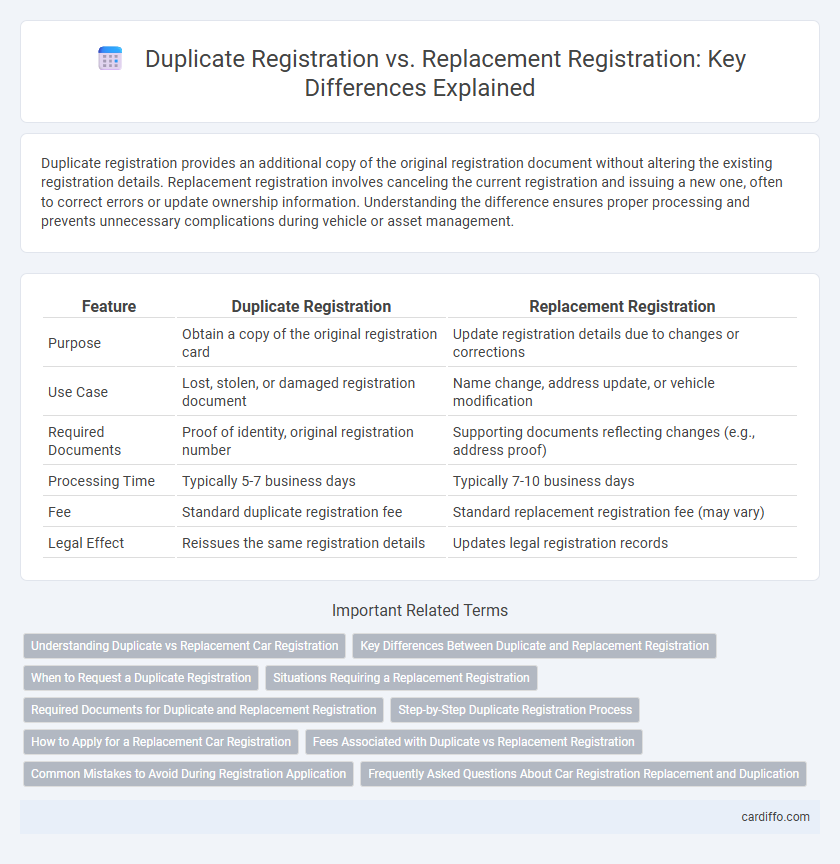Duplicate registration provides an additional copy of the original registration document without altering the existing registration details. Replacement registration involves canceling the current registration and issuing a new one, often to correct errors or update ownership information. Understanding the difference ensures proper processing and prevents unnecessary complications during vehicle or asset management.
Table of Comparison
| Feature | Duplicate Registration | Replacement Registration |
|---|---|---|
| Purpose | Obtain a copy of the original registration card | Update registration details due to changes or corrections |
| Use Case | Lost, stolen, or damaged registration document | Name change, address update, or vehicle modification |
| Required Documents | Proof of identity, original registration number | Supporting documents reflecting changes (e.g., address proof) |
| Processing Time | Typically 5-7 business days | Typically 7-10 business days |
| Fee | Standard duplicate registration fee | Standard replacement registration fee (may vary) |
| Legal Effect | Reissues the same registration details | Updates legal registration records |
Understanding Duplicate vs Replacement Car Registration
Duplicate registration refers to obtaining an additional copy of an existing vehicle registration document when the original is lost or damaged, without altering the registration details. Replacement registration involves issuing a new registration that updates ownership, vehicle information, or corrects errors, effectively superseding the previous record. Understanding the distinction ensures proper handling of registration requests and compliance with Department of Motor Vehicles protocols.
Key Differences Between Duplicate and Replacement Registration
Duplicate registration involves obtaining an additional copy of an original document due to loss, theft, or damage, whereas replacement registration entails canceling the original registration and issuing a completely new registration, often due to changes in ownership or corrections. Key differences include the purpose, where duplicate registration serves as a backup copy without altering the original status, while replacement registration modifies the registration details or ownership. Another distinction lies in the documentation requirements and processing fees, which are typically higher for replacement registrations due to the administrative changes involved.
When to Request a Duplicate Registration
Request a duplicate registration when the original document is lost, stolen, or damaged but the vehicle ownership remains unchanged. Duplicate registration provides a valid replacement without altering the vehicle's registration details or owner information. Replacement registration is required only when there is a need to update or correct the registration information, such as changes in ownership or vehicle modifications.
Situations Requiring a Replacement Registration
Situations requiring a replacement registration typically include loss, theft, or damage of the original registration document, as well as changes in vehicle ownership or significant vehicle modifications. A duplicate registration serves to replace lost or damaged documents without altering vehicle information, whereas a replacement registration updates or corrects the registration details to reflect current status. Understanding these distinctions ensures compliance with state DMV regulations and prevents legal complications.
Required Documents for Duplicate and Replacement Registration
Duplicate registration requires submission of an official application form, a valid identity proof such as a driver's license or passport, and a police report in case of theft or loss of the original registration. Replacement registration mandates documents including the original registration certificate (if damaged), a completed replacement form, proof of identity, and payment receipt for the applicable fees. Both processes may necessitate vehicle inspection reports and insurance certificates depending on regional regulatory requirements.
Step-by-Step Duplicate Registration Process
The step-by-step duplicate registration process begins with submitting a formal application to the relevant authority, accompanied by proof of identity and a police report confirming the loss or damage of the original document. Next, applicants pay the prescribed duplicate fee and provide any additional documentation required for verification. The authority reviews the submission, verifies the details, and issues the duplicate registration certificate within the stipulated processing time, ensuring legal validation of the replacement.
How to Apply for a Replacement Car Registration
To apply for a replacement car registration, submit a completed application form along with proof of identity, vehicle ownership, and payment for the replacement fee to your local Department of Motor Vehicles (DMV). Replacement registration is issued when the original is lost, stolen, or damaged, unlike duplicate registration, which typically refers to obtaining an extra copy without replacing the original. Processing times and required documents may vary by state, so check specific DMV guidelines to ensure a smooth application.
Fees Associated with Duplicate vs Replacement Registration
Fees associated with duplicate registration are generally lower than those for replacement registration, reflecting the administrative differences in processing each request. Duplicate registration fees typically cover the cost of issuing an additional copy of the original registration, while replacement registration fees often include charges for both canceling the previous registration and issuing a new one. Understanding the fee structure helps registrants choose the appropriate service and avoid unnecessary expenses.
Common Mistakes to Avoid During Registration Application
Submitting duplicate registration applications often leads to processing delays and unnecessary fees, while replacement registrations require precise documentation to prevent rejection. Common mistakes include failing to verify existing registrations before applying, providing incomplete or incorrect identification details, and neglecting to include required supporting documents. Ensuring accuracy and thoroughness during the registration application process minimizes errors and accelerates approval.
Frequently Asked Questions About Car Registration Replacement and Duplication
Duplicate registration is issued when the original vehicle registration document is lost, stolen, or damaged, ensuring owners maintain legal proof without changing vehicle details. Replacement registration applies if essential information, such as ownership or vehicle specifications, changes and requires an updated document to reflect current records. Common FAQs include application procedures, necessary documents, fees involved, and processing times for both duplicate and replacement registrations.
Duplicate Registration vs Replacement Registration Infographic

 cardiffo.com
cardiffo.com